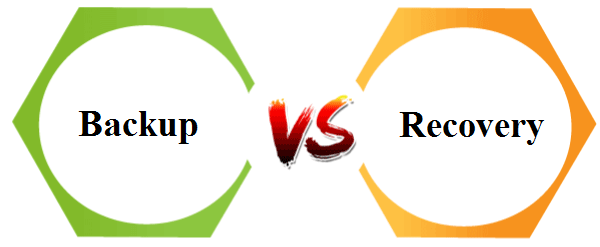Difference between Backup and RecoveryBackup and Recovery both terms are data protection terminology. An efficient backup and recovery system is critical for any firm to secure its precious data. However, backup and recovery are distinct techniques, backup stores a copy of the complete database onto storage media. In contrast, recovery is the process of retrieving lost data from backup storage mediums. In this article, you will learn about the difference between Backup and Recovery. But before discussing the differences, you must know about Backup and Recovery with their features. What is Backup?Backup refers to the storage of a replication of the original data that may be utilized in the event of data loss. Backup is considered one of the best data security methods, and organizations should secure their important data by utilizing the backup process. Backup can be accomplished by storing a backup copy of the original data on storage devices or in a database. The frequency of backup creation might vary depending on the importance of the data. For example, if the data is particularly valuable, it must be backed up daily. Monthly and quarterly backups are the same as daily backups but are only performed on the last day of the month or quarter. Nowadays, backups are created in the cloud due to technological advancements because it offers highly feasible storage and simple management. There are numerous backup types available, including complete backup, incremental backup, local backup, mirror backup, and others. Types of Data BackupThere are mainly three types of data backup, full, incremental, and differential backup. 1. Full Backup It is a simple and full backup procedure that copies all of your data to another media set, including a tape, disk, or CD. As a result, a complete copy of all your data is provided on a single media set. It takes a longer time to complete and takes much storage space. 2. Incremental Backup Incremental backups take up less space and time than differential and full backups, but they are the most time-consuming technique for restoring a full system. They're ideal for backing up data that hasn't changed in a long time. However, there is no method to predict how much space you would use for future backups. 3. Differential Backup Differential backups are a combination of executing complete backups and incremental backups on a regular basis. Differential backups are similar to incremental backups in that they store data about changes to a database or server. These backups make it simple to recover a whole copy of a database or server from a single file. These backups are ideal for swiftly restoring databases and servers without rebuilding everything. These backups are very useful because they allow you to recover a database or server swiftly. You don't have to generate a completely new version of it. Instead, you apply the most recent code changes, restore a differential backup, and have a working copy of the database or server. Features of BackupThere are various features of Backup. Some of the backup features are as follows:
What is Recovery?A database recovery system is an essential component of a Database Management System that assures data consistency even after a system failure. The process of restoring lost data is referred to as recovery. Even if the data was backed up, it could still be recovered by employing various recovery procedures. When a database fails, there is a risk of data loss. Therefore, the recovery procedure aids in improving the database's reliability. Moreover, if any of the transactions fails in the process of some activities, data recovery becomes a critical task and the only option to save the lost data. In this case, the failure could be any type, including system failure, concurrency control enforcement, transaction errors, exception conditions, disk failure, and disasters. Any event that results in downtime would require recovery. There are various recovery processes, including Steal/no-steal and force/no-force policies, shadowing, caching, before and after images of the data item, UNDO, REDO recovery, etc. Features of recoveryThere are various features of Backup. Some of the backup features are as follows:
Key differences between Backup and Recovery There are various key differences between Backup and Recovery. Some of the key differences between the Backup and Recovery are as follows:
Head-to-head comparison between Backup and RecoveryHere, you will learn head-to-head comparisons between Backup and Recovery. The main differences between Backup and Recovery are as follows:
ConclusionBackup and recovery are both the major terms of DBMS. The main distinction between these processes is that backup is a replication of data that may be utilized in the case of a database failure. In contrast, recovery is the technique of restoring a database to its original condition after a failure. Backup allows for recovery, whereas recovery ensures the transaction and data atomicity. Next TopicDifference between |

We provides tutorials and interview questions of all technology like java tutorial, android, java frameworks
G-13, 2nd Floor, Sec-3, Noida, UP, 201301, India












